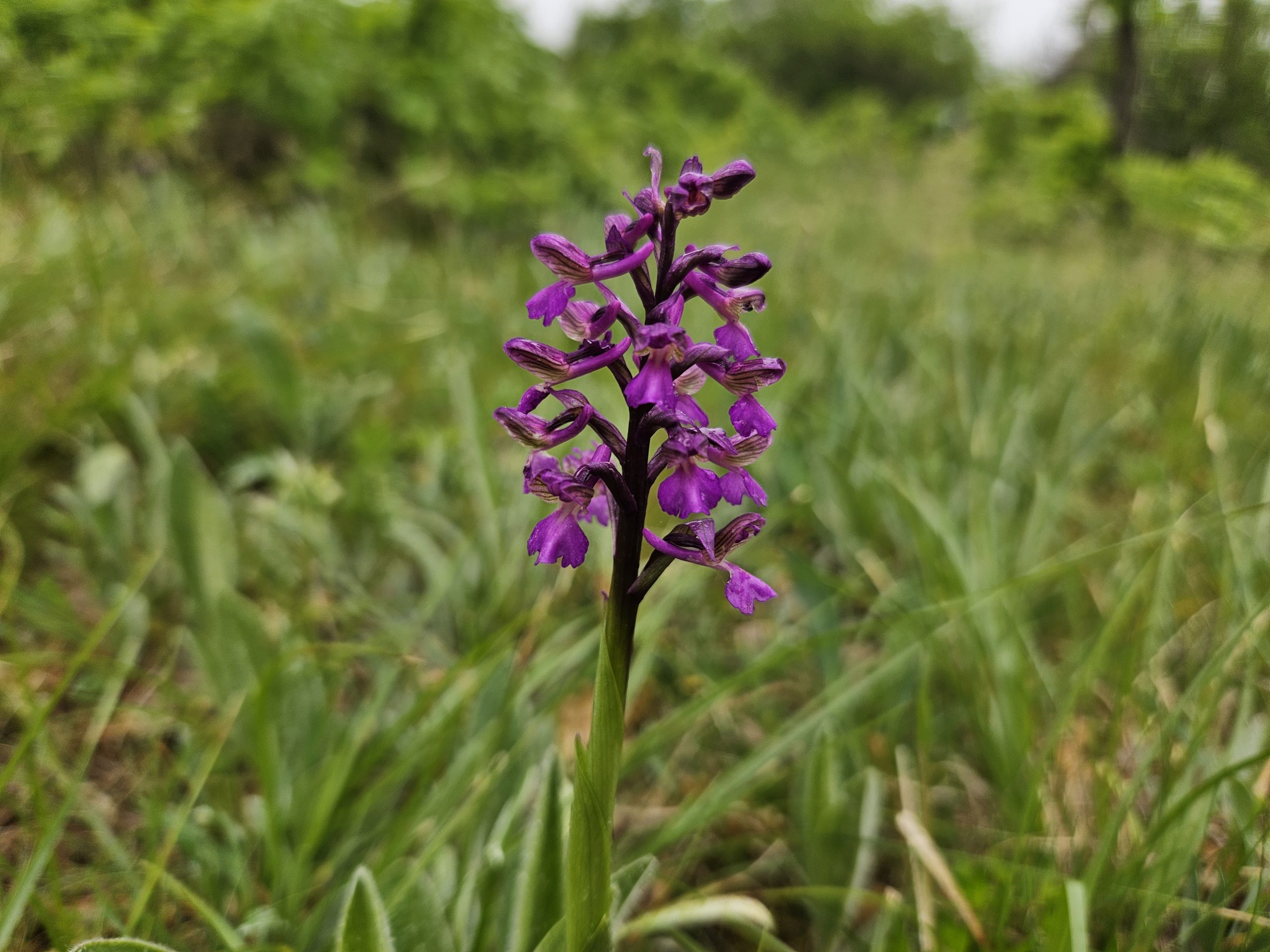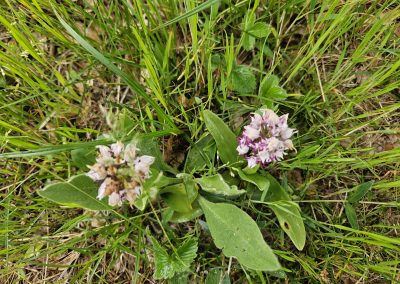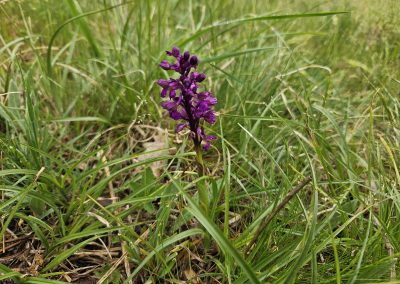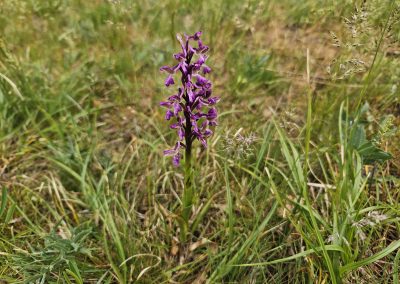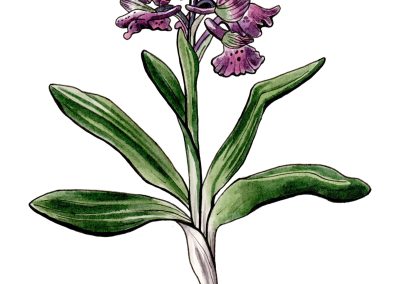Anacamptis morio
Scientific description
Phylum: Angiospermatophyta (Magnoliophyta)
Class: Monocotyledonatae (Liliatae)
Subclass: Liliidae
Order: Asparagales
Family: Orchidaceae
Origin: Widespread across Europe to Western Asia
Common name: Green-Winged Orchid, Morio Orchid
Description:
A striking herbaceous, perennial orchid with underground tubers, 15–40 cm tall. Leaves are narrow, lanceolate, forming a basal rosette. Inflorescence has 5–20 flowers, deep purple to pink, rarely white, with greenish veined lateral sepals resembling “wings”. The lip is broad, three-lobed, often with darker spots. Blooms April–June. Fruit: dry capsule releasing minute seeds.
Propagation: By seed or tuber division.
Ecology:
Found in unimproved grasslands, meadows, and open woodlands, often calcareous soils. Prefers sunny to semi-shaded environments, low nutrients.
Use:
Valued in wildflower gardens and conservation areas for biodiversity.
Threat: Declining due to agricultural intensification, habitat loss, and overgrazing. Protected in many regions.
Încrengătura: Angiospermatophyta (Magnoliophyta)
Clasa: Monocotyledonatae (Liliatae)
Subclasa: Liliidae
Ordinul: Asparagales
Familia: Orchidaceae
Origine: Răspândită din Europa până în Asia de Vest
Denumire comună: Orhideea cu aripi verzi, Orhideea Morio
Descriere:
Plantă erbacee perenă cu tuberculi subterani, 15–40 cm înălțime. Frunzele sunt înguste, lanceolate, în rozetă bazală. Inflorescența poartă 5–20 flori, violet închis spre roz, rareori alb, cu sepale laterale verzi, vene, asemănătoare cu “aripi”. Buza este lată, trilobată, adesea cu pete mai închise. Înflorește aprilie–iunie. Fructul: capsulă uscată cu semințe minuscule.
Înmulțire: Prin semințe sau divizarea tuberculilor.
Ecologie:
Se găsește în pajiști nefertilizate, fânețe și păduri deschise, adesea pe sol calcaros. Preferă locuri însorite sau parțial umbrite, cu sol sărac în nutrienți.
Utilizare:
Apreciată în grădini cu flori sălbatice și în zonele de conservare a biodiversității.
Amenințări: În declin din cauza intensificării agriculturii, pierderii habitatelor și pășunatului excesiv. Protejată în multe regiuni.
Φύλο: Αγγειόσπερμα (Magnoliophyta)
Κλάση: Μονοκοτυλήδονα (Liliatae)
Υποκλάση: Liliidae
Τάξη: Asparagales
Οικογένεια: Orchidaceae
Καταγωγή: Ευρέως διαδεδομένη σε όλη την Ευρώπη έως τη Δυτική Ασία
Κοινή ονομασία: Πράσινη ορχιδέα, Ορχιδέα Morio
Περιγραφή:
Εντυπωσιακή πολυετής ποώδης ορχιδέα με υπόγειους κονδύλους, ύψος 15–40 εκ. Φύλλα στενά, λογχοειδή, σχηματίζουν βασικό ρόδακα. Ταξιανθία με 5–20 άνθη, βαθύ μωβ έως ροζ, σπάνια λευκό, με πράσινα φλεβώδη πλευρικά σέπαλα (“φτερά”). Χείλος πλατύ, τρίλοβο, συχνά με σκούρες κηλίδες. Ανθίζει Απρίλιο–Ιούνιο. Καρπός: ξηρή κάψα με μικροσκοπικούς σπόρους.
Πολλαπλασιασμός: Με σπόρο ή διαίρεση κονδύλων.
Οικολογία:
Μη βελτιωμένα λιβάδια, λιβάδια και ανοιχτά δάση, συχνά ασβεστώδη εδάφη. Προτιμά ηλιόλουστα έως ημισκιερά περιβάλλοντα, χαμηλά επίπεδα θρεπτικών.
Χρήση:
Εκτιμάται σε κήπους με αγριολούλουδα και περιοχές διατήρησης της βιοποικιλότητας.
Απειλή: Σε μείωση λόγω εντατικοποίησης γεωργίας, απώλειας ενδιαιτημάτων και υπερβόσκησης. Προστατεύεται σε πολλές περιοχές.
Embranchement : Angiospermatophyta (Magnoliophyta)
Classe : Monocotylédones (Liliacées)
Sous-classe : Liliidae
Ordre : Asparagales
Famille : Orchidaceae
Origine : Largement répandue en Europe et en Asie occidentale
Nom commun : Orchidée à ailes vertes, Orchidée Morio
Description :
Orchidée herbacée vivace avec tubercules souterrains, 15–40 cm. Feuilles étroites, lancéolées, rosette basale. Inflorescence 5–20 fleurs, pourpre foncé à rose, rarement blanc, sépales latéraux verdâtres veinés (“ailes”). Labelle large, trilobé, souvent taches plus foncées. Floraison avril–juin. Fruit : capsule sèche avec graines minuscules.
Multiplication : Par graines ou division de tubercules.
Écologie:
Prairies non améliorées, prés et bois ouverts, sols calcaires. Préfère soleil à mi-ombre, faible teneur en nutriments.
Utilisation:
Appréciée dans jardins de fleurs sauvages et zones de conservation pour la biodiversité.
Menace: En déclin dû à l’intensification agricole, perte d’habitat, surpâturage. Protégée dans plusieurs régions.
Creative writing inspired by Anacamptis morio
The Meadow’s Gift
In Gaul’s golden, sun-drenched pastures of a bygone day, a woodland spirit called Morina danced amidst the tall grasses. A creature of merry fancy and love of trickery, she delighted in the mimicry of bird song and dexterous shadows, her jests enticing shepherds and travelers alike. Though her jokes sometimes caused a stir, Morina's heart was never wicked; she simply loved laughter and the simple joy of being.
One vivid spring, Flora, the beautiful goddess of wildflowers, came to the meadows in her presence, only to find a haunting quietness. The air was somber, the animals were uneasy, and her dear flowers drooped with a mysterious restlessness. "Why the darkness?" she asked the lark by her side in a soft voice. The bird sang of Morina's endless mischief, relating how the sprite's persistent delusions had sown confusion among animals searching for mates or nurturing young.
Concerned by this disruption, Flora summoned Morina. In a firm and kind voice, the goddess presented the sprite with a choice: be no longer a free spirit but forever excluded from the meadows she clearly loved, or embrace transformation into something beautiful, tied forever to the earth.
The threat of banishment struck Morina's mischievous heart with sharp unexpectedness. She embraced transformation eagerly. With the soft rustle of wind and sparkle of morning dew, Morina was gone. She was succeeded by Anacamptis morio, the green-winged orchid. Its petals still held the bright colors of twilight's roguish tricks, speckled like the freckles of a child's innocence, and its sepals whispered broken wings, a gentle reminder of her former tricks.
This new style, though as lovely as it was, contained a bit of her old reserve, since the orchid only flowered in those wild, untamed areas of the land. And so, to this day, it is said that when the green-winged orchid unfurls its delicate beauty, Morina is near. No longer a shadow-mocker and noise-maker, now she plays in silence through rustling leaves and sunlit glades, finding a new kind of joy in the beauty she has become, a living jewel of the old meadows.


